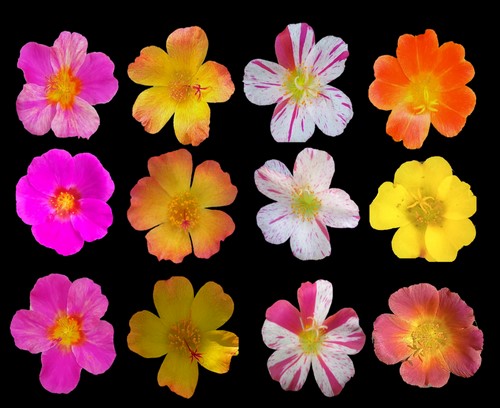Biología floral y evaluación agronómica de tres híbridos de Portulaca umbraticola (Portulacaceae)
DOI:
https://doi.org/10.30972/bon.3326433Keywords:
Biología reproductiva, estigma, híbridos, polen, Portulaca umbraticolaAbstract
Portulaca umbraticola es una planta ornamental de la familia Portulacaceae muy utilizada en jardinería. El objetivo de este estudio fue evaluar la viabilidad polínica, receptividad estigmática y comportamiento agronómico de tres híbridos de Portulaca umbraticola obtenidos en el 2021, Tekila Sunset, Coral Lipstick y Star Blush, en comparación a cultivares comerciales de color rosa, amarillo y naranja de Vigrow Seeds®. Se tomaron mediciones en cinco variables cuantitativas y cinco cualitativas para la evaluación agronómica. La viabilidad polínica y receptividad estigmática se evaluaron mediante la tinción con carmín acético al 1% y peróxido de hidrógeno respectivamente. Se obtuvieron diferencias significativas en las variables cuantitativas (p≤0,05), siendo los cultivares comerciales los de mayor magnitud. Los cultivares de menor y mayor cantidad de polen viable fueron Coral Lipstick y Tekila Sunset con 17,4% y 91,6%, respectivamente. Hubo diferencias significativas (p≤0,05) en cuanto a cultivares, horarios e interacción cultivar × horarios para la receptividad estigmática, la cual fue mayor en el rango de 11:00-3:00 p. m. para la mayoría de los cultivares. Se obtuvieron híbridos agronómicamente adaptados con patrones de coloración novedosos para el mercado ornamental. En futuros programas de mejoramiento se recomienda tomar como parentales masculinos los de mayor viabilidad polínica y realizar las polinizaciones en el rango horario donde el estigma se encuentra más receptivo.
Downloads
References
BABA, N. M, BALOGUN, S. T., ODEY, F. C., DADA, K. E., IDRISU, M., UGIORO, O. & OYELEDUN, K. O. (2020). Evaluation of pollen viability and in vitro pollen germination in relation to different maturity stages of flowers in kola (Cola nítida). Global Scientific Journal 8: 516-525.
BAZZO, S. I., ESPEJO, J. R., PALOMINO, A. C., FLORES, P. F., CHANO, L. M., LÓPEZ, B. C. & MANSILLA, S. R. (2018). Estudios de biología floral, reproductiva y visitantes florales en el “loche” de Lambayeque (iCucúrbita moschata Duchesne). Ecología Aplicada 17: 205-191. http://dx.doi.org/10.21704/rea. vl7i2.1239
BAPTISTE, F. & JONG-YI, F. (2023). Study on pollen viability and stigma receptivity throughout the flowering period in the selected taxa of the Gesneriaceae family. Folia Florticulturae 35: 123-133
BAUM, D. A. & WHITLOCK, B. A. (1999). Plant development: Genetic clues to petal evolution. Current Biology 9: 525-527.
CARRODEGUAS-GONZALEZ, A. & ZÚÑIGA-OROZCO, A. (2023). Métodos utilizados para la selección de parentales en pre-mejoramiento genético de plantas. Cultivos Tropicales 43: el5.
CARRODEGUAS-GONZÁLEZ, A., ZÚÑIGA-OROZCO, A., & ORTIZ-CRÚZ, M. V. (2022). Instrumento de valoración del potencial ornamental de la flora silvestre: Aplicación en orquídeas cubanas. Avances en Investigación Agropecuaria 25: 41-56. https://doi.org/10.53897/RevAIA.21.25.15
DAFNI, A. & FIRMAGE, D. H. (2000). Viabilidad y longevidad del polen: implicaciones prácticas, ecológicas y evolutivas. Plant Systematics and Evolution, 222: 113-132. https://doi.org/10.1007/ BF00984098
DATTA, S. K. (2021). Breeding of ornamentáis: Success and technological status. TheNucleus 65: 107-128
DE FREITAS, L. M., DOS SANTOS PESSOA, A. M., DO REGÓ, E., DOS SANTOS PESSOA, R. M., NOGUEIRA LIMA, E., DA SILVA RIBEIRO, J. E. & CAMPOS DE MAGALHAES, C. H. (2022). Potencial ornamental de accesos de Portulaca umbraticola Kunth. VII Congresso brasileiro de recursos genéticos, Brasil. https://anais.infobibos.com.br/cbrg/7/e-poster.html
Dos SANTOS, J. W. (2010). Sistema reprodutivo de Portulaca grandiflora Hook. com vistas ao melhoramento vegetal. Tesis de Maestría, Universidad Estatal del suroeste de Bahía, Brasil. 135 pp.
GARCÍA, B., QUIROZ, S., YUSTIS, J. C., MARTÍNEZ, T. GARAY-ARROYO, A., SÁNCHEZ, M. & ALVAREZ- BUYLLA, E. (2020). La regulación genética de la floración. Mensaje Bioquímico 44: 20-30
GARCÍA, L., RIVERO, M. & DROPPELMANN, F. (2015). Descripción morfológica y viabilidad del polen de Nothofagus nervosa (Nothofagaceae). Bosque 36: 496-487. https://doi.org/10.4067/S0717-92002015000300015
GONNELLA, M., CHARFEDDINE, M., CONVERSA, G. & SANTAMARÍA, P. (2010). Purslane: a review of its potential for health and agricultural aspects. The European Journal of Plant Science and Biotechnology 4: 131-136.
IMN (2023). Clima del Valle Central de Costa Rica. Instituto Meteorológico Nacional, Costa Rica. https://www.imn.ac.cr/web/imn/mapa (Consulta 03/12/2023).
JYOTI, C., KUMAR, R., RAJASEKHARAN, P. E., NAIR, S. A. & BHARAIHI, T. U. (2023). Pollen germination and stigma receptivity in China áster (Callistephus chinensis Nees). International Journal of Pharmaceutical Science Inventionn 12: 01-03.
KIM, I. & CARR, G. (1990). Reproductive Biology and Uniform Culture of Portulaca in Hawaii. Pacific Science 44: 123-129.
KIM, I. (2013). Morphological Features of Pollen Grains in Portulaca. Applied Microscopy 43: 75-80. https:// doi.org/10.9729/AM.2013.43.2.75
LAGOS, T. C., CAEIANO, C. M., VALLEJO, F. A., MUÑOZ, J. E., CRIOLLO, H. & OLAYA, C. (2005). Caracterización palinológica y viabilidad polínica de Physalis peruviana L. y Physalis philadelphica Lam. Agronomía Colombiana 23: 61-55.
MCINNIS, S. M., EMERY, D. C., PORTER, R., DESIKAN, R., HANCOCK, J. T. & HISCOCK, S. J. (2006). The role of stigma peroxidases in flowering plants insights from further characterization of a stigma-specific peroxidases (SSP) from Senecio squalidus (Asteraceae). Journal of Experimental Botany 8: 1846-1835.
MEKAPOGU, M., SONG, H. Y., LIM, S. H. & JUNG, J. A. (2023). Genetic engineering and genome editing advances to enhance floral attributes in ornamental plants: an Update. Plants 12: 3983. https://doi.org/10.3390/plants12233983
MIYAJIMA, D. (2006) SeedProducing System in Portulaca oleraceae L. Asían joumal Journal of Plant Sciences 5: 226-232.
RODRÍGUEZ, C. (2014). Estudio comparativo de la propagación y el efecto de la radiación lumínica, en una variedad comercial y una población natural de Portulaca olerácea L. Tesis de Grado, Universidad de Sevilla, España. 60 pp. https://idus.us.es/ handle/11441/72586
SANDÍ, H., ZÚÑIGA, A. & CARRODEGUAS, A. (2022). Obtención de híbridos de Portulaca umbraticola a través de cruzamientos convencionales. Revista FAVE-Ciencias Agrarias 2: 85-98. https://doi. org/10.14409/fa. v21 i 1.11124
SOUZA, J. DA S., REGÓ, E. R. DO, FREITAS, N. DE S. S., PESSOA, A. M. DOS S., SILVA, P. D., & REGÓ, M. M. DO. (2023). Phenotypical characterization of Portulaca umbraticola: A non-conventional edible ornamental crop. Acta Scientiarum Agronomy 46: e62326. https://doi.oig/10.4025/actasciagron.v46il.62326
WICKRAMASINGHE, P, HARRISON, D. & JOHNSTON, M. (2009). Reproductive biology and intergeneric breeding compatibility of ornamental Portulaca and Calandrinia (Portulacaceae). Australian Joumal of Botany 57: 697-707. https://doi.org/10.1071/ BT09107
XIE, C., Hu, C., DENG, X., SHAO, W., GAO, Y., HUANG, W., & SONG, X. (2023). Relación entre el color de las flores y los factores físico-químicos celulares en Bletilla striata. Horticulturae 9: 426. https://doi. org/10.3 3 90/horticulturae9040426
ZHANG, J. H., ZENG, J. C., WANG, X. M., CHEN, S. F., ALBACHC, D. & Li, H. Q. (2020). A revised classification of leaf variegation types. Flora 272: 151703.

Downloads
Published
Versions
- 2024-08-28 (4)
- 2024-08-15 (3)
- 2024-07-12 (2)
- 2024-07-12 (1)
How to Cite
Issue
Section
License
Copyright (c) 2024 Bonplandia

This work is licensed under a Creative Commons Attribution 4.0 International License.
Declaration of Adhesion to Open Access
- All contents of Bonplandia journal are available online, open to all and for free, before they are printed.
Copyright Notice
- Bonplandia magazine allows authors to retain their copyright without restrictions.
- The journal is under a Creative Commons Attribution 4.0 International license.














.jpg)


